| dc.contributor.author | İbik, Yunus Emre | |
| dc.contributor.author | Ejder, Nebahat | |
| dc.contributor.author | Sevim, Elif | |
| dc.contributor.author | Rakıcı, Erva | |
| dc.contributor.author | Tanrıverdi, Elif Seren | |
| dc.contributor.author | Çopur Çiçek, Ayşegül | |
| dc.date.accessioned | 2023-11-03T11:41:03Z | |
| dc.date.available | 2023-11-03T11:41:03Z | |
| dc.date.issued | 2023 | en_US |
| dc.identifier.citation | İbik, Y. E., Ejder, N., Sevim, E., Rakıcı, E., Tanrıverdi, E. S. ve Çopur Çiçek, A. (2023). Evaluating molecular epidemiology of carbapenem non-susceptible Klebsiella pneumoniae isolates with MLST, MALDI-TOF MS, PFGE. Annals of Clinical Microbiology and Antimicrobials, 22(1). https://dx.doi.org/10.1186/s12941-023-00640-9 | en_US |
| dc.identifier.issn | 1476-0711 | |
| dc.identifier.uri | https://dx.doi.org/10.1186/s12941-023-00640-9 | |
| dc.identifier.uri | https://hdl.handle.net/20.500.12511/11706 | |
| dc.description.abstract | Background: This study aimed to evaluate antibiotic resistance genes and virulence genes and the clonal relationship of the carbapenem-nonsusceptible Klebsiella pneumoniae strains by molecular methods which are isolated from various clinical specimens from patients treated in tertiary care hospital in Turkey. Methods: Identification of 32 carbapenem non-susceptible K. pneumoniae were determined by VITEK-2 (BioMérieux, France) automated system. Thirteen colistin-resistant strains were tested with the broth microdilution method. Various antibiotic resistance genes and virulence genes frequently seen in carbapenem-resistant strains were screened by PCR. Immunochromatographic tests used in the rapid diagnosis of carbapenemases were compared with PCR results. In addition, PFGE, MLST and MALDI-TOF MS methods were used to determine the clonal relationship among these strains. Results: PCR demonstrated that 31 of the strains carried at least one of the carbapenemase genes. In one strain, the coexistence of bla OXA−48+NDM was shown. The most common resistance genes were determined as bla SHV (84.3%), bla CTX−M−1 (46.8%), bla OXA−48 (40.6%), bla KPC (40.6%), bla TEM (31.2%), bla NDM (18.8%) respectively. Among the virulence genes; magA (68.7%) was the most common, followed by kpn (59.3%) and K2 (9.3%). Immunochromatographic tests were found to be 100% compatible with PCR results. All colistin-resistant isolates were also found to be resistant by colistin broth microdilution. In PFGE analysis, 25 different genotypes were determined and clustering isolates were collected in 5 different clusters and the clustering rate was 35.4%. In MLST analysis, ST101 type was determined as the most common ST type with a rate of 29%. ST101 is followed by ST16, ST307, ST14, ST147, ST309, ST377, ST395 and ST2096, respectively. The compatibility rate between MALDI-TOF MS and VITEK-2 was found 94.3%, in bacterial identification. In MALDI-TOF MS typing, the maximum similarity between the strains was less than 70% and clustering not shown. Conclusion: In addition to OXA-48, which is endemic in our country, it has been determined that KPC, which is more common in the world, is becoming increasingly common in our region. ST101 type was determined as the most common type between the strains. To the best of our knowledge, this is the first study that compares these three methods in our country. There may be differences between bacterial identifications made with VITEK-2 and MALDI-TOF MS. In this study, it was observed that MALDI-TOF MS analyses were not compatible with the typing of strains according to PFGE and MLST analysis results. | en_US |
| dc.description.sponsorship | Recep Tayyip Erdogan University Scientific Research Projects Unit | en_US |
| dc.language.iso | eng | en_US |
| dc.publisher | BioMed Central Ltd | en_US |
| dc.rights | info:eu-repo/semantics/openAccess | en_US |
| dc.rights | Attribution 4.0 International | * |
| dc.rights.uri | https://creativecommons.org/licenses/by/4.0/ | * |
| dc.subject | K. Pneumoniae | en_US |
| dc.subject | Carbapenem | en_US |
| dc.subject | PFGE | en_US |
| dc.subject | MLST | en_US |
| dc.subject | MALDI-TOF MS | en_US |
| dc.title | Evaluating molecular epidemiology of carbapenem non-susceptible Klebsiella pneumoniae isolates with MLST, MALDI-TOF MS, PFGE | en_US |
| dc.type | article | en_US |
| dc.relation.ispartof | Annals of Clinical Microbiology and Antimicrobials | en_US |
| dc.department | İstanbul Medipol Üniversitesi, Tıp Fakültesi, Temel Tıp Bilimleri Bölümü, Tıbbi Mikrobiyoloji Ana Bilim Dalı | en_US |
| dc.authorid | 0000-0002-3673-9670 | en_US |
| dc.identifier.volume | 22 | en_US |
| dc.identifier.issue | 1 | en_US |
| dc.relation.publicationcategory | Makale - Uluslararası Hakemli Dergi - Kurum Öğretim Elemanı | en_US |
| dc.identifier.doi | 10.1186/s12941-023-00640-9 | en_US |
| dc.institutionauthor | Çopur Çiçek, Ayşegül | |
| dc.identifier.wosquality | Q1 | en_US |
| dc.identifier.wos | 001095959600001 | en_US |
| dc.identifier.scopus | 2-s2.0-85175056794 | en_US |
| dc.identifier.pmid | 37891628 | en_US |
| dc.identifier.scopusquality | Q1 | en_US |



















